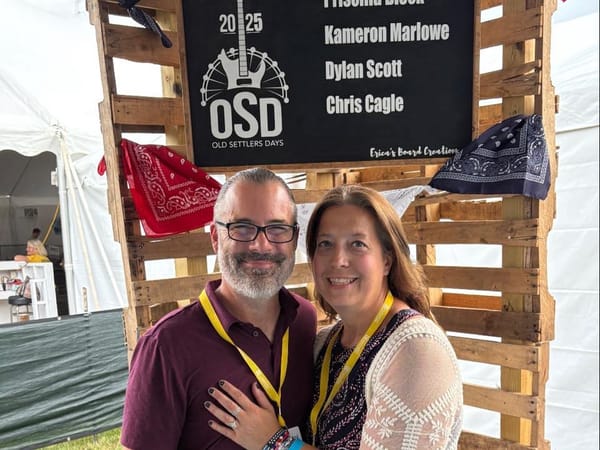Roscoe may be split between three U.S. Congressional districts; hearings begin today
This week, Illinois lawmakers may decide on new Congressional district maps.

Under new Congressional district maps, which may be finalized this week, Roscoe would be split between three different districts, all currently represented by Democrats. In the proposed map, these would be Illinois District 11 (light yellow), Illinois District 17 (blue), and the Illinois District 14 (green). Rockton would entirely within the 17th Illinois District.
Lawmakers unveiled draft congressional maps on Friday, October 15. But if they follow a similar process to the one taken to approve state legislative district maps earlier this year, there will likely be changes to the boundaries ahead of their final passage.
The draft proposal by the Illinois House and Senate Redistricting Committees includes a number of oddly-shaped districts, many of which would create entirely new constituencies for incumbent members of Congress, particularly Republicans.
State lawmakers return to Springfield Tuesday, Oct. 19, for the first of their final two weeks of scheduled session in 2022. Congressional redistricting will be their main topic. Hearings are scheduled for this week to discuss the maps and potential judicial subcircuit changes in certain areas of the state, although public input has thus far been lacking.
Illinois will have 17 congressional districts to draw this year, down from the 18 it had for the past 10 years, due to a population decline since the 2010 U.S Census. Currently, the state has 13 Democratic congressional representatives and five Republicans, but observers have noted the Democrats have several pathways to drawing a map to give the party a 14-3 advantage in the state. The current proposal is one of them.
Right now Illinois District 11, represented in Congress by Bill Foster (D), includes Aurora, Bolingbrook, Napierville, and Joliet. Under the new map, it would add “south Roscoe” (I just made up that name), meaning the Stateline YMCA, Culver's, Main Street Meat and points south, including Kieselburg Forest Preserve, Machesney Park, Loves Park, Midway Village, Argyle, Caledonia, Poplar Grove, Candlewick Lake, Boone County Fairgrounds, Rock Cut State Park but not Rock Valley College.
Illinois District 17, held by retiring U.S. Representative Cheri Bustos (D), includes part of Rockford, Freeport, Galena, East Moline, Galesburg and parts of Peoria. Under the new maps, its borders include Rockton, Schnuck's, Hononegah Road, Blackhawk Barber Shop, most of the churches, and much of Main Street Roscoe. It generally includes Roscoe west of I-90 north of Elevator Road, and south of Elevator Road, it would include west of 2nd Street, Harrison Street, River Street, and the Rock River. After that, it would snake its way along the Mississippi to include Galena, Moline, then turns south and then east to Galesburg, to catch Peoria and Bloomington-Normal. It will include most of Rockford and Belvidere, but not Machesney Park or Loves Park, which will be part of the 11th District. It will also not include Freeport, which goes to the 15th District.
Illinois District 14, held by Lauren Underwood (D), surrounds the Chicago suburbs to the north and west, and includes Harvard, Marengo, Yorkville, Sycamore but not DeKalb. The new map would include both Sycamore and DeKalb. a portion of southeastern South Beloit including Prairie Hill Elementary School (the western boundary mostly follows I-90), a portion of western Village of Roscoe including Roscoe Middle School, the VFW (but not Stepping Stones Child's Center across the street - that's the 17th District), Cross & Crown Lutheran Church and the First Congregational Community Church (but not the Catholic Church of the Holy Spirit down the street or any of the other Roscoe churches - they're all in the 17th District), and part of the bridge on Bridge Street.
Roscoe is currently part of Illinois District 16, represented by Adam Kinzinger (R), who would also be moved into a much different district. Currently the 16th Illinois District covers the area west of the Chicago metropolitan area. Kinzinger would be placed in a new 3rd District that stretches from Oak Lawn south and west to LaSalle. Since Illinois representatives don't have to live in the district they represent, Kinzinger could run for Congress in one of the districts that contains part of his old district, though he may run for Illinois statewide office instead. He is known as one of the few Republicans in Congress who has spoken out against Donald Trump, which would make it hard to survive a primary challenge.
In a statement, Kinzinger said, “I have proudly served six terms in the U.S. House and it has been an honor to do so. Following the release of the new congressional maps for Illinois, my team and I will spend some time looking them over and reviewing all of the options, including those outside the House. This redistricting process has been anything but transparent, which comes as no surprise to anyone. I believe the people of Illinois deserve better.”
The remap effort will have national implications, as it will create the congressional boundaries for the next 10 years, including for the first mid-term election under President Joe Biden next year.
The U.S. House is split 220-212 in favor of Democrats with three seats currently vacant – two last held by Democrats and one last held by a Republican. With Democrats firmly in control of the remap process in Illinois, national observers have noted the state would be pivotal to Democrats maintaining the balance of power in the House.
Illinois could play a pivotal role in the 2022 congressional elections as Democrats try to hold onto their slim majority. The U.S. House is split 220-212 in favor of Democrats with three seats currently vacant – two last held by Democrats and one last held by a Republican.
Historically, however, the party that occupies the White House loses congressional seats in a new president’s first midterm election, a pattern that does not bode well for Democrats. According to FiveThirtyEight, the new maps still include three strongly-Republican districts and three competitive districts held by Democrats. Says FiveThirtyEight, "Should this or a similar version be the final map, Democratic mapmakers may rue not attempting to be even more aggressive."
In Illinois, however, Democrats currently hold a 13-5 majority in the state’s congressional delegation, and Democrats are firmly in control of the redistricting process in the state General Assembly, so it is likely they will do all they can to keep as many Democratic seats as possible.
“Call this new Illinois map the Nancy Pelosi Protection Plan,” Illinois Republican Party Chairman Don Tracy said in a statement. “It’s appalling that fair representation, keeping communities of interest together, and transparency in the mapmaking process in Illinois all had to take a back seat to the demands of national politics.”
The proposed new maps were released after the Illinois House and Senate held a series of public hearings around the state that drew surprisingly little public participation. In fact, several hearings drew no public input at all, while others saw only one or two witnesses speak.
The Illinois General Assembly says that the public could participate via Zoom in "Virtual Room 1," but when Rockton-Roscoe News called them to ask where the Zoom link was for Virtual Room 1, a representative told us links would appear on their web page before a scheduled hearing. None did. One hearing was canceled.
While running for Illinois Governor in 2018, J.B. Pritzker called for a constitutional amendment to set up an independent redistricting commission that was not controlled by the state legislature. He promised to veto maps “in any way drafted or created by legislators, political party leaders and/or their staffs or allies.”
Instead, Gov. Pritzker now says, "I look to the Legislature for their proposal for a redistricting map, I’ll be looking to it for its fairness."
This year, at least according to Crain’s Chicago Business, “three-person panels—comprised of aides to House Speaker Emanuel “Chris” Welch, Senate President Don Harmon and Gov. J.B. Pritzker—have been meeting separately in recent days with every Democratic member of the state’s congressional delegation to see what they want out of decennial reapportionment.”
Many of the nonpartisan advocacy groups that were active during the legislative redistricting process earlier this year took no part in the congressional redistricting process, and some of them cited their frustration with the earlier process as a reason for staying away.
“I'm not surprised to see so few people at the recent redistricting hearings, given the exclusionary Illinois state redistricting process that occurred this year, which resulted in a map that harms communities of color,” Ami Gandhi, senior counsel for the Chicago Lawyers Committee for Civil Rights, said in an email. “Even the community members who have made the effort to analyze and speak out on the maps – especially people of color – have said they don't feel heard and that their input hasn’t mattered. That’s a shame because these maps will absolutely affect our communities’ options, resources, and rights for the next ten years.”
Jay Young, executive director of Common Cause Illinois, said in an interview that there was a general feeling of frustration among many advocacy groups that took part in the legislative redistricting process that has carried over into congressional redistricting.
“I don't know if ‘jaded’ is the right word,” he said. “I mean, there's some folks who are just flat out angry. You know, I have friends that I used to work with in their previous life, who are now part of the General Assembly. I believe that they're still my friends. I know that they care. But even the people that I had better hopes for I don't think did what I had hoped for.”
Democrats said at the time that the new legislative maps were designed to reflect the racial and ethnic diversity of the state. But those maps are now the subject of two ongoing federal lawsuits, including one by a leading Latino advocacy group, the Mexican American Legal Defense and Educational Fund, or MALDEF, whose members have traditionally leaned strongly Democratic.
According to the Chicago Sun-Times, "the map shows three districts drawn to maximize the power of Black voters and one district to amplify Hispanic voting-age population strength — the same as the present map." But a group of Black leaders from Chicago called Illinois African Americans for Equitable Redistricting recently asked the Justice Department to conduct a civil rights investigation into the policies and practices that led to the maps, which they argue dilutes Black voting power.
Besides redistricting, lawmakers are also considering repealing a Parental Notice of Abortion law and making changes to the state’s Health Care Right of Conscience Act to strengthen the governor’s ability to mandate COVID-19 vaccinations or testing requirements, among other potential actions.
Capitol News Illinois provided much of the reporting for this story. The nonprofit, nonpartisan news service covering state government is distributed to more than 400 newspapers statewide, including Rockton-Roscoe News. It is funded primarily by the Illinois Press Foundation and the Robert R. McCormick Foundation.





